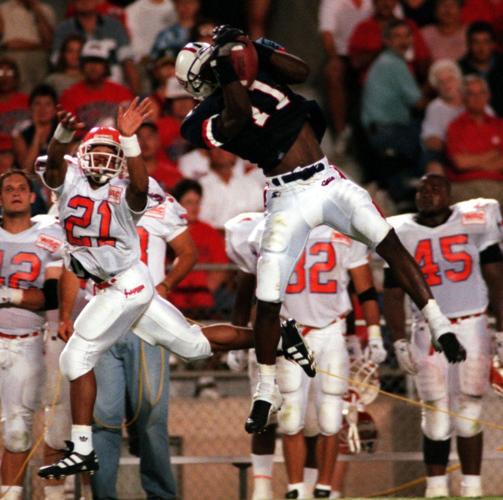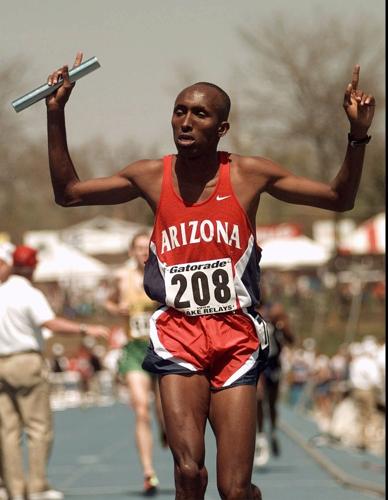Editor’s note: This summer, Star columnist Greg Hansen is counting down the top 10 of just about everything related to Tucson sports. Today’s list: The top 10 junior college transfers to come to UA:
Bennett Davison grew up on a farm in Sebastapol, about 60 miles north of San Francisco. His father was a cable car driver and a singer with the San Francisco Symphony.
In high school, Bennett was more of a soccer player than anything else. He got mild interest from basketball recruiters at St. Mary’s, Santa Clara and USF, but no scholarship offer. When Holy Names University, an Oakland institution, began a men’s basketball program, Davison worked out at the school.
No offer.
So the 6-foot 7-inch athlete, blessed with quickness and jumping ability enrolled at nearby West Valley College, starting with a blank slate. Two years later, Lute Olson saw something in Davison that other coaches missed.
Within a year, Davison was the starting power forward on Arizona’s 1997 national championship team. Assistant coach Jim Rosborough refers to Davison as the best defensive player in his 19 years on the UA staff.
After helping Arizona win 55 games in two seasons, Davison played on 14 foreign teams from Turkey and Italy to Slovenia and Australia. He is clearly one of the leading junior-college transfers in UA history, but did he make the top 10? Here’s our list:
1. Chris McAlister, Mt. San Antonio College. Initially, McAlister planned to leave Pasadena High School to play for UCLA, as his father, all-conference running back James McAlister had done in the 1970s. But UCLA challenged Chris’ high school academic scores, and he enrolled at Mt. San Antonio College. That’s when Dick Tomey, who had coached Chris’ father at UCLA 20 years earlier, got involved. At Arizona, McAlister became the nation’s top cornerback in 1998, leading Arizona to a 12-1 record as McAlister became a consensus All-American and the 10th overall selection in the NFL draft.
2. Gil Heredia, Pima College. A pitcher from Nogales High School, Heredia won 16 games for Arizona’s 1986 College World Series championship team, and 26 in his two Arizona seasons before leaving and ultimately pitching in MLB for 10 years.
3. Gayle Hopkins, Trinidad College, Colorado. A quarterback from Davenport, Iowa, Hopkins enrolled at Trinidad in 1961 and excelled as a long-jumper and high-jumper. He then transferred to Arizona, where he set school records in the long jump, high jump and triple jump and made the 1964 Tokyo Olympic team, before becoming a long-time associate athletic director at Arizona.
4. Pete Williams, Mt. San Antonio College. In his first month as Arizona’s basketball coach, Lute Olson suspected it might be too late to get the athletic, 6-7 forward-center from recruiters at TCU, Colorado and especially UNLV’s Jerry Tarkanian. But Olson and his wife, Bobbi, visited Williams’ home, persuaded him to be part of the UA’s start-up program and he became the cornerstone recruit of the Olson years, an All-Pac-10 player in 1984 and 1985.
5. Abdi Abdirahman, Pima College. A refugee from Somalia, Abdirahman did not compete in track at Tucson High. But when he joined the Pima College team, he became an NJCAA All-American. UA track coach Dave Murray offered Abdirahman a scholarship; he was second in the NCAA in the 1998 cross country finals and went on to be a four-time Olympian.
6. Joe Hernandez, Bakersfield College. After one year at New Mexico Military Institute, Hernandez returned home for a year at Bakersfield College. He was recruited by new UA football coach Jim LaRue, who knew he had a hit when “Jackrabbit Joe” scored three long touchdowns in the 1960 spring game. Hernandez then led the UA in rushing in 1960 and 1961 as the Wildcats went 15-4-1, the best period in school history to that point.
7. George Arias, Pima College. After leading Pueblo High to the state baseball championship and taking PCC to the NJCAA World Series title game, Arias transferred to Arizona in 1993 and broke the school record with 23 home runs and drove in 75. He played four years of MLB.
8. Dave Rohde, Saddleback College. No four-year college recruited the shortstop, so Rohde bumped from Cuesta College to Saddleback when UA assistant coach Jerry Stitt scouted him and told head coach Jerry Kindall that, “He is our missing piece.” Indeed, in 1986, after missing a year with a back injury, Rohde hit .336 at shortstop for Arizona’s 1986 NCAA championship team and later played for the Houston Astros.
9. Trevor Hoffman, Cypress College. Many schools were reluctant to recruit the California infielder because he had just one kidney, traced to an illness as an infant. But Arizona signed him, put him at third base in 1988, and at shortstop in 1989, where he became an All-Pac-10 first-team player on the school’s Pac-10 championship team. Hoffman then switched to pitching in the minor leagues and saved 601 games, the highest total in National League history.
10. Scott Erickson, San Jose City College. A first-team All-American pitcher at San Jose, Erickson went 18-3 in his lone UA season, 1989, the school record for victories before embarking on a 16-year major-league career.






